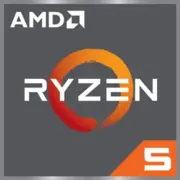AMD Ryzen 5 5500

AMD Ryzen 5 5500: Budget Six-Core CPU for Gaming and Work
Relevant as of April 2025
Key Features: Zen 3, 7nm and Performance Balance
The AMD Ryzen 5 5500, released in 2022, remains a popular budget solution thanks to its favorable combination of price and capabilities.
Architecture and Process Technology
- Codename: Vermeer.
- Architecture: Zen 3 — the same as in the top-tier Ryzen 5000 series.
- Process Technology: TSMC 7nm FinFET. This ensures low power consumption and high efficiency.
- Clock Speeds: Base — 3.6 GHz, Maximum in Turbo Mode — 4.2 GHz.
Performance
- 6 Cores / 12 Threads: Suitable for multitasking and light video editing.
- Cache: 16 MB L3 — less than the Ryzen 5 5600 (32 MB), but sufficient for most tasks.
- Geekbench 6: 1858 (single-core) / 7691 (multi-core). For comparison, the Ryzen 5 5600 scores around ~2000/9000, but is priced higher.
Key Features
- Support for PCIe 4.0: Relevant for fast NVMe drives and GPUs.
- Low TDP (65W): No need for powerful cooling.
- AMD Technologies: Precision Boost 2, StoreMI (storage optimization).
Compatible Motherboards: AM4 and Chipset Choices
The Ryzen 5 5500 utilizes the AM4 socket, offering access to a vast array of boards.
Recommended Chipsets
- B550: Best option. Supports PCIe 4.0, overclocking (e.g., ASUS TUF B550-Plus, $120-$140).
- A520: Budget option without overclocking (Gigabyte A520M S2H, $70-$80).
- X570: Excessive for this CPU, but suitable if you already own such a board.
Features
- BIOS Update: Boards made before 2022 may require an update to work with the Ryzen 5000 series.
- Form Factor: For compact builds, micro-ATX boards are suitable (e.g., MSI B550M Pro-VDH WiFi, $110).
Memory: DDR4 and Optimization
The Ryzen 5 5500 does not support DDR5 — its main drawback in 2025.
Recommendations for RAM
- Type: DDR4.
- Frequency: Optimal at 3200–3600 MHz (e.g., Corsair Vengeance LPX 16GB 3600 MHz, $50).
- Configuration: Dual-channel is essential (2x8GB instead of 1x16GB).
Practical Example
During gaming tests, the difference between DDR4-3200 and DDR4-3600 was 3–5 FPS, but for work tasks (rendering in Blender), memory speed is more critical.
Power Supply: Wattage Calculation
With a TDP of 65W, the Ryzen 5 5500 is not demanding on the PSU.
Recommendations
- Power: 500–600W (with headroom for the GPU).
- Certification: 80+ Bronze or higher (Corsair CX550M, $65).
- Example Build:
- GPU: NVIDIA RTX 4060 (TDP 115W).
- Total: 65W (CPU) + 115W (GPU) + 50W (other components) = 230W. A 550W PSU will be sufficient with margin.
Pros and Cons
Pros
- Price: $120–$130 (new) vs. $170 for the Ryzen 5 5600.
- Energy Efficiency: Ideal for compact PCs.
- Support for PCIe 4.0: Relevant for SSDs and GPUs.
Cons
- No DDR5: At a disadvantage compared to newer budget CPUs like the Intel Core i5-13400F.
- Smaller L3 Cache: Trails behind the Ryzen 5 5600 by 10–15% in games.
- No Integrated Graphics: Requires a discrete GPU.
Use Cases
Gaming
- 1080p / Medium Settings: 60+ FPS in Cyberpunk 2077 with RTX 3060.
- Esports Titles: Valorant, CS2 — 200+ FPS.
Work Tasks
- Office Applications: Multitasking without lag.
- Video Editing: Rendering in Premiere Pro takes 15–20 minutes for a 10-minute 1080p video.
Multimedia
- Streaming: GPU's NVENC reduces CPU load.
Comparison with Competitors
1. Intel Core i5-12400F ($130):
- Pros: Better in single-core tasks (~1950 in Geekbench 6).
- Cons: Requires LGA 1700 platform, and DDR5 is more expensive.
2. Ryzen 5 5600 ($170):
- Pros: +20% performance in games, more cache.
- Cons: Higher price.
3. AMD Ryzen 5 7500F ($180):
- Pros: Zen 4, DDR5, AM5 (future upgrade).
- Cons: 50% more expensive.
Practical Assembly Tips
1. Cooler: The stock Wraith Stealth is sufficient, but for quiet operation, consider the DeepCool Gammaxx 400 ($25).
2. Case: Ensure good ventilation (e.g., NZXT H510 Flow, $80).
3. BIOS: Update the BIOS via USB Flashback before installing the CPU (if the board is older).
Final Verdict: Who is the Ryzen 5 5500 For?
This processor is an excellent choice for those who:
- Are building a PC for under $600 and want to save on the CPU without sacrificing gaming performance.
- Are looking to upgrade an old AM4 system (e.g., from Ryzen 3 3100).
- Do not plan to switch to DDR5 in the next 2–3 years.
Alternatives: If the budget allows, it's better to go for the Ryzen 5 5600 or Intel i5-13400F. However, at $120–$130, the Ryzen 5 5500 remains the best in its segment.
Prices are relevant as of April 2025. Listed for new devices in U.S. retail stores.
Basic
CPU Specifications
Memory Specifications
GPU Specifications
Miscellaneous
Benchmarks
Compared to Other CPU
Share in social media
Or Link To Us
<a href="https://cputronic.com/en/cpu/amd-ryzen-5-5500" target="_blank">AMD Ryzen 5 5500</a>



